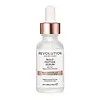What's inside
What's inside
 Key Ingredients
Key Ingredients

 Benefits
Benefits

 Concerns
Concerns

No concerns
 Ingredients Side-by-side
Ingredients Side-by-side

Water
Skin ConditioningPropanediol
SolventGlycerin
HumectantButylene Glycol
HumectantXanthan Gum
EmulsifyingSodium Benzoate
MaskingPotassium Sorbate
PreservativeDisodium EDTA
Carbomer
Emulsion StabilisingHydroxypropyl Cyclodextrin
MaskingDipeptide Diaminobutyroyl Benzylamide Diacetate
Skin ConditioningPolysorbate 20
EmulsifyingPalmitoyl Tripeptide-38
Skin ConditioningPalmitoyl Tripeptide-1
Skin ConditioningPalmitoyl Tetrapeptide-7
Skin ConditioningWater
Skin ConditioningPropanediol
SolventGlycerin
HumectantIsononyl Isononanoate
EmollientButylene Glycol
HumectantPentylene Glycol
Skin ConditioningDextrin Palmitate/Ethylhexanoate
EmulsifyingLimnanthes Alba Seed Oil
Skin ConditioningHelichrysum Italicum Flower Oil
MaskingOriganum Majorana Leaf Extract
AntiseborrhoeicAcmella Oleracea Extract
Skin ProtectingHelianthus Annuus Seed Oil
EmollientAdenosine
Skin ConditioningPhenoxyethanol
PreservativeCarbomer
Emulsion StabilisingMaltodextrin
AbsorbentSodium Hydroxide
BufferingPalmitic Acid
EmollientDisodium EDTA
Cellulose Gum
Emulsion StabilisingAmodimethicone
Tocopherol
AntioxidantParfum
MaskingCI 75130
Cosmetic ColorantWater, Propanediol, Glycerin, Isononyl Isononanoate, Butylene Glycol, Pentylene Glycol, Dextrin Palmitate/Ethylhexanoate, Limnanthes Alba Seed Oil, Helichrysum Italicum Flower Oil, Origanum Majorana Leaf Extract, Acmella Oleracea Extract, Helianthus Annuus Seed Oil, Adenosine, Phenoxyethanol, Carbomer, Maltodextrin, Sodium Hydroxide, Palmitic Acid, Disodium EDTA, Cellulose Gum, Amodimethicone, Tocopherol, Parfum, CI 75130
 Reviews
Reviews

Ingredients Explained
These ingredients are found in both products.
Ingredients higher up in an ingredient list are typically present in a larger amount.
Butylene Glycol (or BG) is used within cosmetic products for a few different reasons:
Overall, Butylene Glycol is a safe and well-rounded ingredient that works well with other ingredients.
Though this ingredient works well with most skin types, some people with sensitive skin may experience a reaction such as allergic rashes, closed comedones, or itchiness.
Learn more about Butylene GlycolCarbomer is a polymer of acrylic acid. Its main role is to create a gel consistency.
A high amount of carbomer can cause pilling or balling up of products. Don't worry, most products contain 1% or less of carbomer.
Disodium EDTA plays a role in making products more stable by aiding other preservatives.
It is a chelating agent, meaning it neutralizes metal ions that may be found in a product.
Disodium EDTA is a salt of edetic acid and is found to be safe in cosmetic ingredients.
Learn more about Disodium EDTAGlycerin is already naturally found in your skin. It helps moisturize and protect your skin.
A study from 2016 found glycerin to be more effective as a humectant than AHAs and hyaluronic acid.
As a humectant, it helps the skin stay hydrated by pulling moisture to your skin. The low molecular weight of glycerin allows it to pull moisture into the deeper layers of your skin.
Hydrated skin improves your skin barrier; Your skin barrier helps protect against irritants and bacteria.
Glycerin has also been found to have antimicrobial and antiviral properties. Due to these properties, glycerin is often used in wound and burn treatments.
In cosmetics, glycerin is usually derived from plants such as soybean or palm. However, it can also be sourced from animals, such as tallow or animal fat.
This ingredient is organic, colorless, odorless, and non-toxic.
Glycerin is the name for this ingredient in American English. British English uses Glycerol/Glycerine.
Learn more about GlycerinPropanediol is an all-star ingredient. It softens, hydrates, and smooths the skin.
It’s often used to:
Propanediol is not likely to cause sensitivity and considered safe to use. It is derived from corn or petroleum with a clear color and no scent.
Learn more about PropanediolWater. It's the most common cosmetic ingredient of all. You'll usually see it at the top of ingredient lists, meaning that it makes up the largest part of the product.
So why is it so popular? Water most often acts as a solvent - this means that it helps dissolve other ingredients into the formulation.
You'll also recognize water as that liquid we all need to stay alive. If you see this, drink a glass of water. Stay hydrated!
Learn more about Water